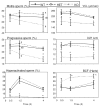Expression of the gene for mouse lactate dehydrogenase C (Ldhc) is required for male fertility
- PMID: 18367675
- PMCID: PMC2574787
- DOI: 10.1095/biolreprod.108.068353
Expression of the gene for mouse lactate dehydrogenase C (Ldhc) is required for male fertility
Abstract
The lactate dehydrogenase (LDH) protein family members characteristically are distributed in tissue- and cell type-specific patterns and serve as the terminal enzyme of glycolysis, catalyzing reversible oxidation reduction between pyruvate and lactate. They are present as tetramers, and one family member, LDHC, is abundant in spermatocytes, spermatids, and sperm, but also is found in modest amounts in oocytes. We disrupted the Ldhc gene to determine whether LDHC is required for spermatogenesis, oogenesis, and/or sperm and egg function. The targeted disruption of Ldhc severely impaired fertility in male Ldhc(-/-) mice but not in female Ldhc(-/-) mice. Testis and sperm morphology and sperm production appeared to be normal. However, total LDH enzymatic activity was considerably lower in Ldhc(-/-) sperm than in wild type sperm, indicating that the LDHC homotetramer (LDH-C(4)) is responsible for most of the LDH activity in sperm. Although initially motile when isolated, there was a more rapid reduction in the level of ATP and in motility in Ldhc(-)(/-) sperm than in wild-type sperm. Moreover, Ldhc(-/-) sperm did not acquire hyperactivated motility, were unable to penetrate the zona pellucida in vitro, and failed to undergo the phosphorylation events characteristic of capacitation. These studies showed that LDHC plays an essential role in maintenance of the processes of glycolysis and ATP production in the flagellum that are required for male fertility and sperm function.
Figures








Similar articles
-
Human lactate dehydrogenase A (LDHA) rescues mouse Ldhc-null sperm function.Biol Reprod. 2013 Apr 18;88(4):96. doi: 10.1095/biolreprod.112.107011. Print 2013 Apr. Biol Reprod. 2013. PMID: 23467744 Free PMC article.
-
Lactate dehydrogenase C and energy metabolism in mouse sperm.Biol Reprod. 2011 Sep;85(3):556-64. doi: 10.1095/biolreprod.111.091546. Epub 2011 May 12. Biol Reprod. 2011. PMID: 21565994 Free PMC article.
-
Glycolysis and mitochondrial respiration in mouse LDHC-null sperm.Biol Reprod. 2013 Apr 18;88(4):95. doi: 10.1095/biolreprod.113.108530. Print 2013 Apr. Biol Reprod. 2013. PMID: 23486916 Free PMC article.
-
LDHC: the ultimate testis-specific gene.J Androl. 2010 Jan-Feb;31(1):86-94. doi: 10.2164/jandrol.109.008367. Epub 2009 Oct 29. J Androl. 2010. PMID: 19875487 Free PMC article. Review.
-
Sperm glucose transport and metabolism in diabetic individuals.Mol Cell Endocrinol. 2014 Oct;396(1-2):37-45. doi: 10.1016/j.mce.2014.08.005. Epub 2014 Aug 13. Mol Cell Endocrinol. 2014. PMID: 25128846 Review.
Cited by
-
Lactate Dehydrogenase C Produces S-2-Hydroxyglutarate in Mouse Testis.ACS Chem Biol. 2016 Sep 16;11(9):2420-7. doi: 10.1021/acschembio.6b00290. Epub 2016 Jul 7. ACS Chem Biol. 2016. PMID: 27333189 Free PMC article.
-
A Comparative Analysis of the Altered Levels of Human Seminal Plasma Constituents as Contributing Factors in Different Types of Male Infertility.Curr Issues Mol Biol. 2021 Sep 26;43(3):1307-1324. doi: 10.3390/cimb43030093. Curr Issues Mol Biol. 2021. PMID: 34698062 Free PMC article.
-
TLRR (lrrc67) interacts with PP1 and is associated with a cytoskeletal complex in the testis.Biol Cell. 2010 Jan 13;102(3):173-89. doi: 10.1042/BC20090091. Biol Cell. 2010. PMID: 19886865 Free PMC article.
-
Lack of tyrosylprotein sulfotransferase-2 activity results in altered sperm-egg interactions and loss of ADAM3 and ADAM6 in epididymal sperm.J Biol Chem. 2011 Apr 15;286(15):13060-70. doi: 10.1074/jbc.M110.175463. Epub 2011 Feb 21. J Biol Chem. 2011. PMID: 21339297 Free PMC article.
-
Energy Metabolism and Hyperactivation of Spermatozoa from Three Mouse Species under Capacitating Conditions.Cells. 2022 Jan 10;11(2):220. doi: 10.3390/cells11020220. Cells. 2022. PMID: 35053337 Free PMC article.
References
-
- Everse J, Kaplan NO. Lactate dehydrogenases: structure and function. Adv Enzymol Relat Areas Mol Biol. 1973;37:61–133. - PubMed
-
- Goldberg E. Reproductive implications of LDH-C4 and other testis-specific isozymes. Exp Clin Immunogenet. 1985;2:120–124. - PubMed
-
- Wheat TE, Goldberg E. An allelic variant of the sperm-specific lactate dehydrogenase C4 (LDH-X) isozyme in humans. J Exp Zool. 1977;202:425–430. - PubMed
-
- Coonrod S, Vitale A, Duan C, Bristol-Gould S, Herr J, Goldberg E. Testis-specific lactate dehydrogenase (LDH-C4; Ldh3) in murine oocytes and preimplantation embryos. J Androl. 2006;27:502–509. - PubMed
-
- Goldberg E. Lactate dehydrogenase-X from mouse testes and spermatozoa. Methods Enzymol. 1975;41:318–323. - PubMed
Publication types
MeSH terms
Substances
Grants and funding
LinkOut - more resources
Full Text Sources
Other Literature Sources
Molecular Biology Databases

